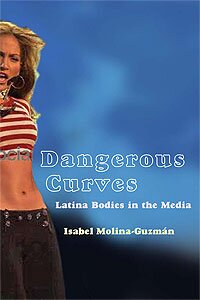
Isabel Molina-Guzman
NYU Press (2010)
Reviewed by Ernesto Aguilar
I have occasional conversations with associates about the unusual political and cultural space occupied by Latinos, and the challenges young Latinas in particular face. Often sexualized and objectified by mainstream white culture as exotic succubi, Latinas further occupy a racialized place of privilege that Black women are not permitted. Their access to white privilege, in varying degrees, creates a series of unique social questions that the broader Latina/o community struggles to address or simply avoids. As conceptions of race and gender shift, how mainstream society sees women of Latin or South American descent is an evolving area of study today. Pop culture, as with any instance of Othering, is especially harsh.
White Western sensibilities, notions of Latinidad and feminist aesthetics collide in Dangerous Curves: Latina Bodies in the Media by Isabel Molina-Guzman (New York University Press, 2010). While not fully addressing issues of Latina/o privilege related to whiteness and Blackness, it is nevertheless a thought-provoking book that reveals some insights into continental debates on Latina/o identity. If you are familiar with discussions of how mainstream media represents and misrepresents people of color, a lot in Dangerous Curves will not be new to you, but there are still plenty of diverse examples, from TV’s Ugly Betty to films like Spanglish. Molina-Guzman investigates how presumptions of conservative Latina/o politics (embodied in family-values cultural mores and religious faith) as well as Latina nubility contrasted with white beauty standards, cast Latinas into a position for white consumers that is at once more primal than traditional white images, but safer than Blackness, which is oftentimes far more scrutinized by mainstream media. More subtly, Dangerous Curves relates how the pressure to sell shapes key decisions in telling a story. Whether it is playing up Frida Kahlo’s sexual orientation over her socialist political beliefs via Salma Hayek’s portrayal in Frida or Jennifer Lopez as a diva, globalization and capital play a role here that cries out to be challenged more fully.
If there is a missing spot in Dangerous Curves, it is taking these observations beyond the academic and into the realm of affecting lives.
At times, I am skeptical of talking up reprehensible media images of people of color for fear of falling into similar traps. Are there negative images of people of color in mainstream media? Absolutely. Seen in the light of mass media’s penetration and ability to present images, Dangerous Curves is a necessary indictment for how the press and advertisers portray Latinas. But one cannot help but wonder, after completing the book, about possible organizing opportunities. An unexamined question is, how much would work with communities of color in both media and cultural literacy, as well as who we spend our money supporting, address many misgivings? A decade or more into the Internet and social media boom, is the overblown caricature approach of tabloids and gossip websites really the story, or is it the dereliction of duty among Latina/o intelligentsia to fortify communities, and the capitulation of alleged leadership to industry?
My overall critique of the approach exemplified somewhat in Dangerous Curves and elsewhere, which condemns (objectionable) media images, is that there is implicitly a belief that a solution lies in corporate America cleaning up its act. Latina stereotypes are indubitably pervasive, but aren’t we simply picking low-hanging fruit when the focus becomes how they represent members of our community? Without openly exploring corporate America’s history for coopting and opposing movements, including the Black liberation struggle, and not providing a systemic or otherwise institutional critique for how these tools of capitalist exchange — that being information and access — function, those drawing out a critique are reduced to wagging our fingers at the tabloids and corporations. Honestly saying these corporations are not friends of Latina/o communities is a bald contradiction of Latina/o assimilationist movements that have courted corporate acceptance at the cost of being in a politically unwinnable position. Such a position seeks better representation by businesses and media that are not actually politically aligned with or in solidarity with Latina/o cultural and political needs, views us primarily as customers or potential customers, or else serves interests that may use us as a wedge for white supremacy aimed at the Black community. After all, the discussion about Latinos displacing Blacks as the largest minority is a much more comfortable conversation for the powerful than how their society has failed people of African descent. Similarly, it is easy to say Shakira has whitened her image and how such resonates for many young Latinas, yet the larger media representation puzzle, alternatives, self-determination and who is responsible for addressing issues are not so clear.
Dangerous Curves is a good starting place to begin talking media justice, and offers a window to get into the more provocative conversation, which is not as excavated but gets a serviceable introduction.
See the original post here: Dangerous Curves: Latina Bodies in the Media

Sun, Jul 18, 2010
Latin America, Publication Reviews